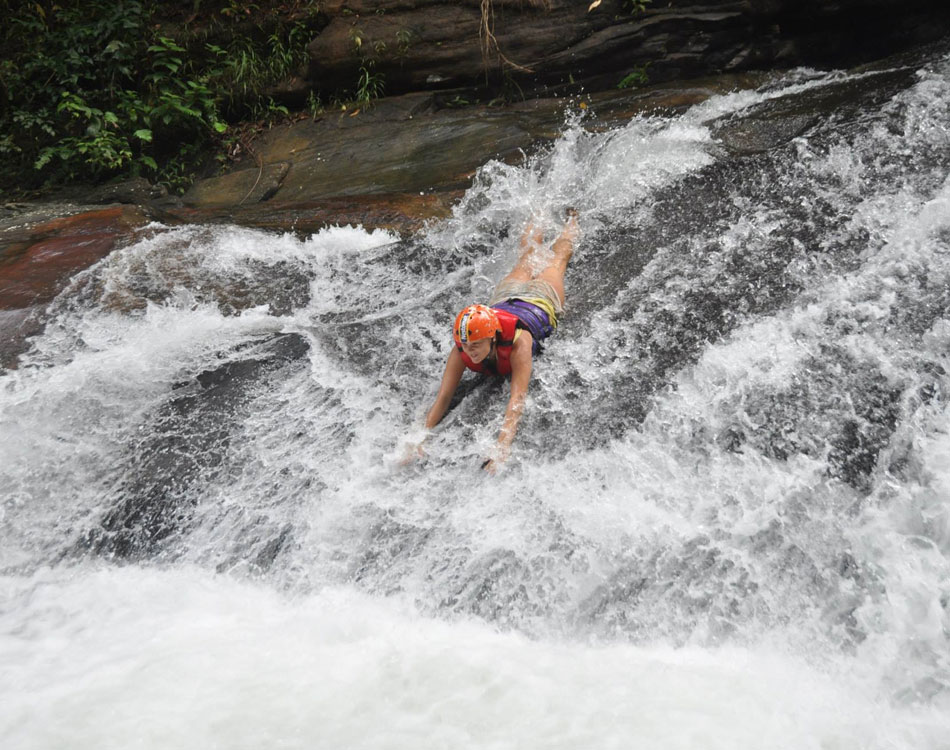CANYONING IN KITULGALA
Nestled amidst lush green hills along the A7 main road, about 80 kilometers from Colombo, lies the picturesque town of Kitulgala in Sri Lanka. Enveloped in tropical vegetation, the town derives its name from the Kitul palm tree, which is abundant in the area. These palm groves not only add to the scenic beauty but also serve practical purposes, as the Kitul sap extracted from them is utilized in various ways. From crystallizing to produce jaggery to fermenting for palm wine, Kitul sap forms a significant part of the local economy and culture.
Kitulgala's geographical location contributes to its unique charm. Situated in a rainforest area, the town experiences two monsoon seasons annually, making it one of the wettest places in Sri Lanka. However, it springs to life during the first three months of the year, particularly in February, which happens to be the driest month. This juxtaposition of abundant rainfall and dry spells creates an environment ripe for exploration and adventure.
One of Kitulgala's claims to fame is its association with the Academy Award-winning movie "The Bridge on the River Kwai." While the actual bridge from the movie may no longer stand, the scenic Kelani River, where filming took place, remains a central attraction. Today, Kitulgala serves as the primary hub for white-water rafting in Sri Lanka, drawing adventure enthusiasts from far and wide.
Weekends witness a surge in visitors from Colombo, drawn by the promise of breathtaking scenery and a plethora of outdoor activities. Whether it's immersing oneself in the cool waters of the Kelani River, embarking on jungle walks, or indulging in adventurous waterfall jumps and slides, Kitulgala offers something for everyone. Moreover, the local restaurants serve up delicious rice and curry lunches, providing a perfect culinary respite after a day of exploration.
Birdwatching is another popular activity in Kitulgala, attracting avid birders eager to spot endemic species amidst the verdant surroundings. While the rainforest here hosts many bird species found in the prestigious World Biosphere Reserve at Sinharaja, the more open terrain makes sightings easier, especially of elusive endemic species like the Sri Lanka Spurfowl, Green-billed Coucal, and Spot-winged Thrush.
For those seeking a more immersive experience, camping opportunities abound within the jungles of Kitulgala. Combining camping with activities like white-water rafting, birdwatching, jungle walks, and river bathing allows visitors to truly connect with nature and indulge in adventurous pursuits.
One of the most exhilarating activities offered in Kitulgala is canyoning. This adventurous sport involves navigating through canyons using a variety of techniques, including walking, scrambling, climbing, abseiling, and swimming. With its rugged terrain, narrow gorges, and spectacular waterfalls, Kitulgala provides an ideal setting for canyoning enthusiasts of all skill levels. From technical descents requiring rope work to more leisurely hikes through canyons, there's something for everyone to enjoy.
Canyoning gear, including climbing hardware, ropes, helmets, wetsuits, and specialized footwear, ensures a safe and enjoyable experience for participants. As the popularity of canyoning grows, so does the availability of specialized gear designed to enhance the adventure.
In conclusion, Kitulgala stands as a premier destination for adventure and leisure, offering a perfect blend of natural beauty and adrenaline-pumping activities. Whether you're seeking an adrenaline rush or a serene escape into nature, Kitulgala has it all. So, if you're looking for an adventure close to Colombo, look no further than Kitulgala – where every corner holds a new thrill and every moment is an adventure waiting to unfold.
Day Tours
See more
See less
Round Tours
See more
See less
Things To Do
See more
See less

